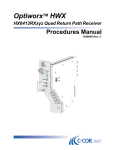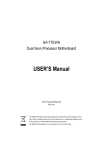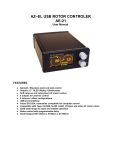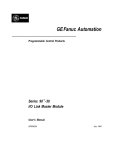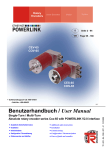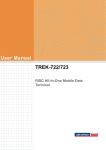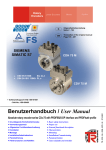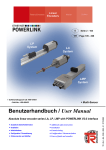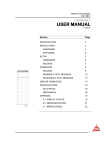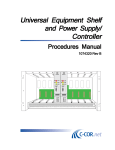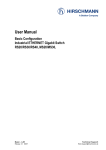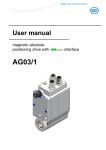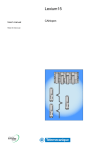Download - TR Electronic
Transcript
Translation of the original manual Absolute Encoder CDx-75 POWERLINK/openSAFETY Explosion Protection Enclosure _A**75* _A**88* CDH 75 M SIL CL3 PL e CDV 75 M _Safety instructions _Device-specific specifications _Installation/commissioning _Parameterization _Error causes and remedies User Manual Interface TR - ECE - BA - GB - 0110 - 00 02/13/2015 DIN EN 61508: DIN EN ISO 13849: Contents TR-Electronic GmbH D-78647 Trossingen Eglishalde 6 Tel.: (0049) 07425/228-0 Fax: (0049) 07425/228-33 E-mail: [email protected] http://www.tr-electronic.de Copyright protection This Manual, including the illustrations contained therein, is subject to copyright protection. Use of this Manual by third parties in contravention of copyright regulations is not permitted. Reproduction, translation as well as electronic and photographic archiving and modification require the written content of the manufacturer. Violations shall be subject to claims for damages. Subject to modifications The right to make any modifications in the interest of technical progress is reserved. Document information Release date / Rev. date: Document / Rev. no.: File name: Author: 02/13/2015 TR - ECE - BA - GB - 0110 - 00 TR-ECE-BA-GB-0110-00.docx MÜJ Font styles Italic or bold font styles are used for the title of a document or are used for highlighting. Courier font displays text that is visible on the screen and software/software menu selections. ″< > ″ indicates keys on your computer keyboard (such as <RETURN>). Brand names Products, names and logos in this Manual are only mentioned for information purposes and may be brands of their owners without this fact being expressly declared. TR-Electronic GmbH 2015, All Rights Reserved Page 2 of 55 Printed in the Federal Republic of Germany TR - ECE - BA - GB - 0110 - 00 02/13/2015 Contents Contents .................................................................................................................. 3 Revision index ........................................................................................................ 6 1 General ................................................................................................................. 7 1.1 Scope ...................................................................................................................................... 7 1.2 References.............................................................................................................................. 8 1.3 Abbreviations and terms used ................................................................................................ 9 1.4 Main features .......................................................................................................................... 11 1.5 Principle of the safety function ................................................................................................ 12 2 Safety instructions .............................................................................................. 13 2.1 Definition of symbols and notes .............................................................................................. 13 2.2 Organizational measures ........................................................................................................ 13 2.3 Safety functions of the fail-safe processing unit ..................................................................... 14 2.3.1 Mandatory safety checks / measures ..................................................................... 14 3 Technical data...................................................................................................... 15 3.1 Safety ...................................................................................................................................... 15 3.2 Electrical specifications ........................................................................................................... 15 3.2.1 General ................................................................................................................... 15 3.2.2 Device-specific specifications ................................................................................. 16 3.3 Max. possible step deviation (master system / test system) .................................................. 17 4 Installation / preparation for commissioning .................................................... 18 4.1 Basic rules .............................................................................................................................. 18 4.2 POWERLINK transmission technology, cable specification ................................................... 19 4.3 Connection .............................................................................................................................. 20 4.3.1 Supply voltage ........................................................................................................ 21 4.3.2 POWERLINK .......................................................................................................... 22 4.3.3 Incremental interface / SIN/COS interface.............................................................. 22 4.4 EPL node ID............................................................................................................................ 23 4.4.1 Setting by means of hardware switches ................................................................. 23 4.4.2 Setting through POWERLINK SDO access, optional ............................................. 23 4.5 Incremental interface / SIN/COS interface ............................................................................. 24 4.5.1 Signal characteristics .............................................................................................. 25 4.5.2 Optional HTL level, 13…27 VDC ............................................................................ 26 5 Commissioning .................................................................................................... 27 5.1 POWERLINK / openSAFETY ................................................................................................. 27 5.2 Device description file ............................................................................................................. 27 5.3 Bus status display ................................................................................................................... 28 5.3.1 Indicator states and flashing frequency .................................................................. 28 5.3.2 Link / data activity LEDs.......................................................................................... 28 TR-Electronic GmbH 2015, All Rights Reserved Printed in the Federal Republic of Germany 02/13/2015 TR - ECE - BA - GB - 0110 - 00 Page 3 of 55 Contents 5.3.3 POWERLINK status LED ........................................................................................ 29 5.3.4 openSAFETY status LED ....................................................................................... 29 5.4 IP addressing .......................................................................................................................... 30 5.5 Commissioning using the B&R X20 CPU ............................................................................... 30 6 Process data structure ........................................................................................ 31 6.1 Safety instrumented data ........................................................................................................ 31 6.1.1 Input data ................................................................................................................ 32 6.1.1.1 TR status ................................................................................................... 32 6.1.1.2 Velocity ...................................................................................................... 33 6.1.1.3 Multi-turn / single-turn ................................................................................ 33 6.1.1.4 Scaled actual value ................................................................................... 34 6.1.2 Output data ............................................................................................................. 35 6.1.2.1 TR control .................................................................................................. 35 6.1.2.2 Preset multi turn / Preset single turn ......................................................... 35 6.2 NON safety instrumented process data .................................................................................. 36 6.2.1 Input data ................................................................................................................ 36 6.2.1.1 Cams ......................................................................................................... 36 6.2.1.2 Velocity ...................................................................................................... 37 6.2.1.3 Multi turn / single turn ................................................................................ 37 6.2.1.4 Scaled actual value ................................................................................... 38 7 POWERLINK object directory ............................................................................. 39 7.1 Communication-specific standard objects, EPSG DS-301 ..................................................... 39 7.2 Manufacturer-specific objects ................................................................................................. 40 7.2.1 Object 2000h: DeviceConfiguration ........................................................................ 40 7.2.2 Object 4000h: Indata_safe ...................................................................................... 40 7.2.3 Object 4001h: Outdata_safe ................................................................................... 40 7.2.4 Object 4010h: grayData .......................................................................................... 40 7.3 Profile-specific standard objects, CiA DS-406 ........................................................................ 41 7.4 Access to the POWERLINK object directory .......................................................................... 41 8 openSAFETY object directory ............................................................................ 42 8.1 Access to the openSAFETY object directory.......................................................................... 42 9 Parameterization .................................................................................................. 43 9.1 Safety instrumented parameters............................................................................................. 43 9.1.1 VIT Rotary Direction................................................................................................ 43 9.1.2 Integration Time ...................................................................................................... 43 9.1.3 Window Increments ................................................................................................ 44 9.1.4 Idleness Preset Tolerance ...................................................................................... 44 9.2 NON safety instrumented parameters .................................................................................... 44 9.2.1 Integration time (unsafe) ......................................................................................... 44 10 Output of forced variable values (substitute values) ..................................... 45 11 Preset adjustment function .............................................................................. 46 11.1 Sequence using the safety control ....................................................................................... 46 TR-Electronic GmbH 2015, All Rights Reserved Page 4 of 55 Printed in the Federal Republic of Germany TR - ECE - BA - GB - 0110 - 00 02/13/2015 12 Troubleshooting and diagnosis options ......................................................... 47 12.1 Optical displays ..................................................................................................................... 47 12.1.1 Link status, PORT1: LED1; PORT2: LED2........................................................... 47 12.1.2 POWERLINK status, LED3 ................................................................................... 47 12.1.3 openSAFETY status, LED4 .................................................................................. 48 12.2 Manufacturer-specific diagnosis (Powerlink object) ............................................................. 49 13 Checklist, part 2 of 2.......................................................................................... 50 14 Appendix ............................................................................................................ 51 14.1 TÜV certificate ...................................................................................................................... 51 14.2 POWERLINK certificate ........................................................................................................ 52 14.3 openSAFETY certificate ....................................................................................................... 53 14.4 EC Declaration of Conformity ............................................................................................... 54 14.5 Drawings ............................................................................................................................... 55 TR-Electronic GmbH 2015, All Rights Reserved Printed in the Federal Republic of Germany 02/13/2015 TR - ECE - BA - GB - 0110 - 00 Page 5 of 55 Revision index Revision index Revision Date First edition 02/13/2015 TR-Electronic GmbH 2015, All Rights Reserved Page 6 of 55 Index 00 Printed in the Federal Republic of Germany TR - ECE - BA - GB - 0110 - 00 02/13/2015 1 General The present interface-specific User Manual addresses the following topics: ● Safety instructions ● Device-specific specifications ● Installation/commissioning ● Parameterization ● Error causes and remedies Since it has a modular structure, this User Manual is supplementary to other documentations, such as product data sheets, dimensional drawings, brochures, the Safety Manual, etc. The User Manual may be included in the customer’s specific delivery package or it may be requested separately. 1.1 Scope This User Manual is only applicable to measuring system model ranges having the following type designation codes and featuring the POWERLINK interface and openSAFETY protocol: *1 *2 Position *1 *2 *3 *4 *5 *6 *3 *4 Designation A C D V H S 75 88 M - *5 - *6 *6 *6 *6 *6 Description Explosion protection enclosure (ATEX); Absolute encoder, programmable Redundant dual scanning system Solid shaft Hollow shaft Blind-hole shaft External diameter ∅ 75 mm External diameter ∅ 88 mm Multi-turn Consecutive number * = Wild card The products are labeled with affixed nameplates and are components of a system. This means that, all in all, the following documentations are applicable: ● The responsible organization’s system-specific operating instructions ● This User Manual ● The Safety Manual TR-ECE-BA-GB-0107 that is included in the delivery ● Optional: User Manual TR-Electronic GmbH 2015, All Rights Reserved Printed in the Federal Republic of Germany 02/13/2015 TR - ECE - BA - GB - 0110 - 00 Page 7 of 55 General 1.2 References 1. EPSG DS-301 Ethernet POWERLINK Communication Profile 2. EPSG WDP-304 openSAFETY Profile Specification 3. CiA DS-406 CANopen profile for encoders IEC 61158-300 Digital data communications for measurement and control - Fieldbus for use in industrial control systems - Part 300: Data Link Layer service definition IEC 61158-400 Digital data communications for measurement and control - Fieldbus for use in industrial control systems - Part 400: Data Link Layer protocol specification IEC 61158-500 Digital data communications for measurement and control - Fieldbus for use in industrial control systems - Part 500: Application Layer service definition IEC 61158-600 Digital data communications for measurement and control - Fieldbus for use in industrial control systems - Part 600: Application Layer protocol specification IEC 61784-2 Digital data communications for measurement and control - Additional profiles for ISO/IEC 8802-3 based communication networks in real-time applications ISO/IEC 8802-3 Carrier Sense Multiple Access with Collision Detection (CSMA/CD) Access Method and Physical Layer Specifications 4. 5. 6. 7. 8. 9. 10. IAONA Guide 11. ISO/IEC 11801, EN 50173 Industrial Ethernet - Planning and Installation Guide Information technology - Generic cabling for customer premises TR-Electronic GmbH 2015, All Rights Reserved Page 8 of 55 Printed in the Federal Republic of Germany TR - ECE - BA - GB - 0110 - 00 02/13/2015 1.3 Abbreviations and terms used 0x Hexadecimal representation A**75* Explosion protection enclosure with ∅ 75 mm and built-in measuring system, all variants A**88* Explosion protection enclosure with ∅ 88 mm and built-in measuring system, all variants Automation Studio Programming tool by B&R CAT Category: Cable classification also used for Ethernet CDx Absolute encoder with redundant dual scanning system, all designs CiA CAN in Automation. international users' and manufacturers' organization: non-profit organization for CAN (Controller Area Network) CN Controlled Node: node in the EPL network without ability to control the “slot communication network management” (slave) CRC DCavg Cyclic Redundancy Check Diagnostic Coverage Average diagnostic coverage EC European Community EMC ElectroMagnetic Compatibility EPL Ethernet PowerLink EPSG ETHERNET Powerlink Standardization Group Forced values If the peripheral devices are safety instrumented and feature outputs, the safety instrumented system does not transmit the output values which the safety program provides in the process image to the fail-safe outputs in the event of an error but sends substitute values (e.g., 0) instead. Hub A hub interconnects various network segments, e.g., in an Ethernet network. IAONA Industrial Automation Open Networking Alliance IEC International Electrotechnical Commission IP Internet Protocol ISO International Organization for Standardization MAC Media Access Control, Ethernet ID MNnmt Managing Node: node in the EPL network with the ability to control the “slot communication network management” (master) TR-Electronic GmbH 2015, All Rights Reserved Printed in the Federal Republic of Germany 02/13/2015 TR - ECE - BA - GB - 0110 - 00 Page 9 of 55 General Continued MTTFd NMT PDO PFDav Mean Time To Failure (dangerous) Network Management. One of the service elements in the application layer in the CAN reference model. Executes initialization, configuration and error handling in bus traffic. Process Data Object. Object for data exchange among multiple devices. Average Probability of Failure on Demand Average probability of failure of a safety function with low demand PFH Probability of Failure per Hour Operating mode with high requirement rate or continuous demand. Probability of dangerous failure per hour. S/UTP Shielded/Unshielded Twisted Pair SDO Service Data Object. Point-to-point communication with access to the object data list of a device. SCS Safety Integrity Level: Four discrete levels (SIL1 to SIL4). The higher the SIL of a safety instrumented system, the lower the probability that the system cannot execute the required safety functions. Slot Timeslice Repeat test (proof test) Recurrent test for detecting hidden dangerous failures in a safety instrumented system. XDD XML device description file XML EXtensible Markup Language TR-Electronic GmbH 2015, All Rights Reserved Page 10 of 55 Printed in the Federal Republic of Germany TR - ECE - BA - GB - 0110 - 00 02/13/2015 1.4 Main features ● ● ● ● ● POWERLINK interface with openSAFETY protocol, for transfer of a safe position and velocity Fast process data channel via POWERLINK, not safety instrumented Variant 1 only: Additional incremental or SIN/COS interface, not safety instrumented Two-channel scanning system, for generation of safe measured data through internal channel comparison – Variant 1: Channel 1, master system: Optical single-turn scanning via code disk with transmitted light and magnetic multi-turn scanning Channel 2, test system: Magnetic single- and multi-turn scanning – Variant 2: Channel 1, master system: Magnetic single- and multi-turn scanning Channel 2, test system: Magnetic single- and multi-turn scanning One common drive shaft The data of the master system are provided in the non safety instrumented process data channel with normal POWERLINK protocol (untested) and short cycle time. The inspection system is used for the internal safety check. The “safe data” that are obtained through two-channel data comparison are packed into the openSAFETY protocol and also transmitted to the POWERLINK control via POWERLINK. The data are also provided to the openSAFETY control through cross traffic. The incremental interface available in variant 1, or the optionally available SIN/COS interface, is derived from the master system and is not evaluated in relation to safety. TR-Electronic GmbH 2015, All Rights Reserved Printed in the Federal Republic of Germany 02/13/2015 TR - ECE - BA - GB - 0110 - 00 Page 11 of 55 General 1.5 Principle of the safety function System safety is established as follows: – Each of the two scanning channels is largely fail-safe thanks to individual diagnostic measures. – The measuring system internally compares the positions detected by both channels in two channels, also determines the velocity in two channels and transfers the safe data to a downstream safety instrumented control in the openSAFETY protocol via POWERLINK. – In the event of a failed channel comparison or other error detected through internal diagnostic mechanisms, the measuring system switches the openSAFETY channel to error state. – Initialization of the measuring system and execution of the preset adjustment function are appropriately safeguarded. – The control additionally checks whether the obtained position data are within the position window expected by the control. Unexpected position data are, e.g., position jumps, following error deviations and incorrect direction of travel. – In case errors are detected, the control introduces appropriate safety measures defined by the system manufacturer – The system manufacturer ensures, through correct attachment of the measuring system, that the measuring system is always driven by the axis to be measured and is not overloaded. – The system manufacturer performs a safeguarded test during commissioning and whenever a parameter has been changed. TR-Electronic GmbH 2015, All Rights Reserved Page 12 of 55 Printed in the Federal Republic of Germany TR - ECE - BA - GB - 0110 - 00 02/13/2015 2 Safety instructions 2.1 Definition of symbols and notes means that death or serious injury will occur if the user fails to take the respective precautionary measures. means that death or serious injury may occur if the user fails to take the respective precautionary measures. means that minor injuries may occur if the user fails to take the respective precautionary measures. means that damage to property may occur if the user fails to take the respective precautionary measures. indicates important information or features and application tips for the product used. 2.2 Organizational measures ● ● This User Manual must always be kept ready-to-hand at the place of use of the measuring system. Prior to commencing work, personnel assigned to handle the measuring system must – have read and understood the Safety Manual, in particular chapter “Basic safety instructions”, – as well as this User Manual, in particular chapter “Safety instructions”. This is particularly applicable for personnel who handle the measuring system only occasionally, e.g., when the measuring system is parameterized. TR-Electronic GmbH 2015, All Rights Reserved Printed in the Federal Republic of Germany 02/13/2015 TR - ECE - BA - GB - 0110 - 00 Page 13 of 55 Safety instructions 2.3 Safety functions of the fail-safe processing unit The measuring system does not decide on valid motion states of the system in which it is installed. The system must check the position information provided by the measuring system and the expected motion of the system for consistency. The safety control to which the measuring system is connected, must perform the following safety checks. To ensure the appropriate measures can be taken in the event of an error, the following applies: If the measuring system detects an error and a safe position cannot be output, the openSAFETY channel is put into the Pre-Operational state and then automatically passed over to the fail-safe state; openSAFETY status LED = red. In this state, “forced variable values” are output via the openSAFETY channel. See also chapter “Output of forced variable values (substitute values)” on page 45. Fail-safe state as seen by the measuring system: – openSAFETY state: Pre-Operational – openSAFETY frame: Data are set to 0 – openSAFETY module: SafeModuleOk: invalid Upon receipt of forced data, the safety control must put the system into a safe state. It is only possible to leave this error state by eliminating the error and then switching the supply voltage of the measuring system off and on again! This does not necessarily affect the process data channel that can be addressed via POWERLINK. If the internal diagnosis in the master channel does not detect an error, the process data are still output. Module status: ModuleOk=valid. However, these data are not safe in terms of a safety standard. 2.3.1 Mandatory safety checks / measures Measures for commissioning, changes Error response Application-dependent parameterization of the openSAFETY parameters, see chapter “Safety – instrumented parameters” on page 43. In the event of parameter changes, check whether the STOP measure is taken as desired. Check by safety control Cyclic check of the current safety instrumented openSAFETY data for consistency with the previous data. STOP Check of the openSAFETY position information of the measuring system for consistency with the motion of the system. STOP Monitoring of cycle openSAFETY data. SafeModuleOk = false --> STOP Timeout: Monitoring of the measuring system – response time. To check, e.g., for cable breakage, power failure, etc. STOP TR-Electronic GmbH 2015, All Rights Reserved Page 14 of 55 Error response Printed in the Federal Republic of Germany TR - ECE - BA - GB - 0110 - 00 02/13/2015 3 Technical data 3.1 Safety Startup time ............................................... Time between POWER-UP and safe position output Overall system .................................. Approx. 17 s, B&R: X20CP1584 (1 ms) with X20SL8010 PFH, operating mode ............................... 3.96*10 -10 1/h -9 Scanning system, double magnetic .. 2.30*10 1/h PFDav (T1 = 20 a) ........................................ 3.45 10 -5 MTTFd ......................................................... 88 a, HIGH Scanning system, double magnetic .. 110 a * DCavg ........................................................ 98%, HIGH Scanning system, double magnetic .. 98.87% Internal process safety time .................... Time elapsing between occurrence of a safetyrelevant error and output of an alarm Overall system .................................. ≤ 6 ms Process safety angle ................................ Angle between error occurrence and output of an alarm Via channel-internal self-diagnosis .. ± 100°, relating to the measuring system shaft, at 6000 min-1 Through channel comparison ........... Parameterizable using the Window Increments parameter T1, repeat test (proof test) ........................ 20 years * Was assessed according to Note 2 on Table 6 of EN ISO 13849-1 3.2 Electrical specifications 3.2.1 General Supply voltage ....................................... 13…27 V DC acc. to IEC 60364-4-41, SELV/PELV Feed .............................................. Common feed, however, electrically isolated from each other via two power supply units Reverse polarity protection ........... Yes Short-circuit protection .................. Yes, by internal 2 A safety fuse Overvoltage protection .................. Yes, up to ≤ 36 V DC Current consumption without load ...... ≤ 165 mA at 24 V DC Optional HTL level, 13…27 VDC .. Increased current consumption, see page 26 TR-Electronic GmbH 2015, All Rights Reserved Printed in the Federal Republic of Germany 02/13/2015 TR - ECE - BA - GB - 0110 - 00 Page 15 of 55 Technical data 3.2.2 Device-specific specifications Total resolution ...................................... ≤ 268 435 456 steps Number of steps / revolution ................ ≤ 8192 Number of revolutions .......................... ≤ 32768 Functional accuracy .............................. 8192 steps, single-turn Scanning system, double magnetic .. 256 steps, single-turn Accuracy Can be used for safety purposes .. 128 steps, single-turn Safety principle ...................................... 2 redundant scanning systems with internal triangulation POWERLINK Interface........................... Acc. to IEC 61158 et seq. and IEC 61784-2 Safety Profile Specification ........... EPSG WDP-304 V1.4.0 openSAFETY Additional functions ....................... Preset * Parameter - Integration time Safe............... - Integration time Unsafe........... - Size of monitoring window ...... - Idleness Preset tolerance ....... - Counting direction ................... POWERLINK specification ............ Physical layer ................................ Communication profile................... Output code ................................... Device profile................................. Bus cycle time ............................... Transmission rate .......................... Transmission ................................. * TR-specific functions................... 50 ms…500 ms 5 ms…500 ms 50…4000 increments 1...5 increments/Integration time Safe Forward, backward V2.0 POWERLINK 100Base-TX, Fast Ethernet, ISO/IEC 8802-3 EPSG DS-301 V1.1.0 Binary Based on CiA DS-406 ≥ 400 µs 100 Mbit/s Cat5e cable S/UTP (netting), ISO/IEC 11801 Velocity output in increments/Integration time Safe Incremental interface Availability ..................................... Pulses / revolution ......................... A, /A, B, /B, TTL ............................ A, /A, B, /B, HTL ............................ Output frequency, TTL .................. Output frequency, HTL .................. For cable specification, see page 22 Scanning system: optical/magnetic 4096, 8192, 12288, 16384, 20480, via factory setting RS422 (2-wire) according to EIA standard Optionally 13…27 V DC, see page 26 ≤ 500 KHz See page 26 SIN/COS interface, alternative Availability ..................................... Number of periods ......................... SIN+, SIN–, COS+, COS– ............ Short-circuit proof .......................... For cable specification, see page 22 Scanning system: optical/magnetic 4096 / revolution 1 Vss ± 0.2 V at 100 Ω, differential Yes Cycle time NOT safety instrumented .............. 0.5 ms Safety instrumented ...................... 5 ms Preset write cycles ................................ ≥ 8 000 000 * parameterizable via POWERLINK TR-Electronic GmbH 2015, All Rights Reserved Page 16 of 55 Printed in the Federal Republic of Germany TR - ECE - BA - GB - 0110 - 00 02/13/2015 3.3 Max. possible step deviation (master system / test system) Figure 1: Dynamic view of the step deviation, in ascending counting direction (view onto flanging) Function of straight line S1: S1 = 30 steps + (0.11 steps per revol. * actual speed [1/min]) Function of straight line S2: S2 = -30 steps + (-0.0024 steps per revol. * actual speed [1/min]) The max. possible step deviation results from the difference between S1 and S2 Example: Max. possible step deviation at 3500 1/min S1 = 30 steps + (0.11 steps per revol. * 3500 1/min) = 415 steps S2 = -30 steps + (-0.0024 steps per revol. * 3500 1/min) = -38.4 steps Max. possible step deviation = 415 steps – (-38.4 steps) = 453.4 steps TR-Electronic GmbH 2015, All Rights Reserved Printed in the Federal Republic of Germany 02/13/2015 TR - ECE - BA - GB - 0110 - 00 Page 17 of 55 Installation / preparation for commissioning 4 Installation / preparation for commissioning 4.1 Basic rules The safety function may be deactivated by line-borne disturbance sources! All openSAFETY devices used on the bus must have a POWERLINK certificate and an openSAFETY certificate. All safety instrumented devices must also have a certificate from a “Notified Body” (e.g., TÜV, BIA, HSE, INRS, UL, etc.). The 24V power supplies used may not cut out in the event of a fault in the energy supply (safe under single fault conditions) and must fulfill SELV/PELV supply requirements. The shielding effect of cables must also be ensured after installation (bending radii/tensile strength!) and after connector changes. In cases of doubt, use more flexible cables with a higher current carrying capacity. Only use M12 connectors for connecting the measuring system, which ensure good contact between the cable shield and the connector housing. Connect the cable shield to the connector housing over a large area. Compensating currents caused by differences in potential across the shield to the measuring system must be prevented. A shielded and stranded data cable must be used to ensure high electromagnetic interference stability of the system. The shield should be connected to protective ground in a well-conducting manner using large-scale shield clips, if possible on either end. The shielding should be grounded in the switch cabinet on one end only if the machine ground is heavily contaminated with interference towards the switch cabinet ground. Equipotential bonding measures must be provided for the complete processing chain of the system. Power and signal cables must be laid separately. During installation, observe the applicable national safety and installation regulations for data and power cables. Observe the manufacturer's instructions for the installation of converters and for shielding power cables between frequency converter and motor. Ensure adequate dimensioning of the energy supply. TR-Electronic GmbH 2015, All Rights Reserved Page 18 of 55 Printed in the Federal Republic of Germany TR - ECE - BA - GB - 0110 - 00 02/13/2015 Upon completion of installation, a visual inspection with report should be carried out. Whenever possible, the quality of the network should be verified using a suitable bus analysis tool: no duplicate IP addresses, no reflections, no telegram repetitions, etc. To ensure safe and fault-free operation, - ISO/IEC 11801, EN 50173 (European standard) - ISO/IEC 8802-3 - EPSG DS 301, Communication Profile Specification, chapter “Physical Layer”, - IAONA Guide “Industrial Ethernet - Planning and Installation Guide” chapters “Cable” and “System Installation”, http://www.iaona-eu.com, - and the standards and directive referenced therein must be observed! In particular the EMC directive in its valid version must be observed! 4.2 POWERLINK transmission technology, cable specification Safety instrumented openSAFETY communication is embedded in the POWERLINK standard protocol and transmitted via the same network. S/UTP Cat5e must be used for transmission according to the 100Base-TX Fast Ethernet standard (overall shield with 2 x 2 twisted pair unshielded copper wires). The cables are designed for bit rates of up to 100 Mbit/s. The transmission velocity is automatically detected by the measuring system and does not have to be set by means of switches. Select half duplex operation for transmission, and deactivate the automatic detection function. We recommend that you use class 2 hubs for setting up the EPL network. The cable length between two users may not exceed 100 m. TR-Electronic GmbH 2015, All Rights Reserved Printed in the Federal Republic of Germany 02/13/2015 TR - ECE - BA - GB - 0110 - 00 Page 19 of 55 Installation / preparation for commissioning 4.3 Connection The measuring system may be destroyed or damaged or its function be impaired by ingress of moisture! Connector plugs of the measuring system that are unused during storage and/or operation of the system have to be provided either with a mating connector or with a protective cap. The IP degree of protection is to be selected according to requirements. Protective cap with O-ring: When re-closing, check that the O-ring is present and seated properly. For suitable protective caps, see the chapter on accessories in the Safety Manual. Figure 2: Connector assignment TR-Electronic GmbH 2015, All Rights Reserved Page 20 of 55 Printed in the Federal Republic of Germany TR - ECE - BA - GB - 0110 - 00 02/13/2015 4.3.1 Supply voltage The internal electronics may be damaged by impermissible overvoltages and this damage go unnoticed! • If an overvoltage of >36 V DC is inadvertently applied, the measuring system must be checked at the factory. If overvoltage is applied for more than 200 ms, the measuring system will be permanently switched off for safety reasons. The measuring system must be shut down immediately When sending the measuring system to the factory, the reasons and circumstances relating to the overvoltage must be specified The power supply used must meet the requirements of SELV/PELV (IEC 60364-4-41:2005) X1 Signal Description 1 + 24 V DC (13…27 V DC) Supply voltage 2 n.c. - 3 0V GND 4 n.c. - Pin, M12x1, 4 pole Cable specification: min. 0.34 mm2 (recommended 0.5 mm2) and shielded. Generally, the cable cross-section must be harmonized with the cable length. TR-Electronic GmbH 2015, All Rights Reserved Printed in the Federal Republic of Germany 02/13/2015 TR - ECE - BA - GB - 0110 - 00 Page 21 of 55 Installation / preparation for commissioning 4.3.2 POWERLINK X2 Signal Description 1 TxD+, transmit data + 2 RxD+, receive data + 3 TxD–, transmit data – 4 RxD–, receive data – 4-pin female connector, M12x1 PORT 2 X3 Signal Description 1 TxD+, transmit data + 2 RxD+, receive data + 3 TxD–, transmit data – 4 RxD–, receive data – 4-pin female connector, M12x1 PORT 1 4.3.3 Incremental interface / SIN/COS interface X4 1 ) 1) 1) 1) Signal Description 1 Channel B + 5 V differential / 13…27 V DC 2 Channel B – 5 V differential / 13…27 V DC 3 Channel A + 5 V differential / 13…27 V DC 4 Channel A – 5 V differential / 13…27 V DC 0 V, GND Data reference potential 5 5-pin female connector, M12x1 Alternative with SIN/COS signals X4´ Signal Description 1 SIN + 1 Vss, differential 2 SIN – 1 Vss, differential 3 COS + 1 Vss, differential 4 COS – 1 Vss, differential 5 0 V, GND Data reference potential 5-pin female connector, M12x1 Cable specification: min. 0.25 mm2 and shielded. To guarantee the signal quality and minimization of possible environmental influences, we urgently recommend to use a shielded twisted pair cable. 1) TTL/HTL level variant: see nameplate TR-Electronic GmbH 2015, All Rights Reserved Page 22 of 55 Printed in the Federal Republic of Germany TR - ECE - BA - GB - 0110 - 00 02/13/2015 4.4 EPL node ID Every EPL node, MN/CN router, is addressed via an 8-bit EPL node ID on the EPL layer. This ID may be assigned only once within one EPL segment and is therefore only relevant to the local EPL segment. Node IDs 1...239 may be assigned to the measuring system. 4.4.1 Setting by means of hardware switches The measuring system may be destroyed or damaged or its function be impaired by penetration of foreign bodies and ingress of moisture! The access to the hardware switches must be firmly closed with the screw plug after the settings have been made. The node ID is set using two HEX rotary switches which are read only at the starting moment. Subsequent settings during ongoing operation will no longer be detected. Figure 3: EPL node ID, switch assignment 4.4.2 Setting through POWERLINK SDO access, optional This setting option can only be used if the housing variant does not feature any access to the hardware switches for tightness reasons. Index Subindex 2300h 0 1 2 3 Comment No. of entries Current node ID NodeIDByHW SWNodeID Default value 3 224 on delivery 0 - Type UNSIGNED8 UNSIGNED8 BOOLEAN UNSIGNED8 Attr. ro ro ro rw Procedure suggested: ● Initially, do not connect the measuring system to the actual automation net. Instead, connect the measuring system as a single component to a POWERLINK control or a PC featuring a standard Ethernet network card and POWERLINK SDO communication option (UDP/IP). Refer to chapter “IP addressing”, see page 30. ● Put the measuring system to the NMT_CS_BASIC_ETHERNET state ● Write the desired EPL node IP to index 2300h, subindex 3 ● Turn the supply voltage to the measuring system off and on again – The desired EPL node IP is applied to subindex 1 as the current EPL node ID and stored permanently ● Take the same steps to set other measuring systems. ● Finally, connect all measuring systems to the automation net. TR-Electronic GmbH 2015, All Rights Reserved Printed in the Federal Republic of Germany 02/13/2015 TR - ECE - BA - GB - 0110 - 00 Page 23 of 55 Installation / preparation for commissioning 4.5 Incremental interface / SIN/COS interface In addition to the POWERLINK interface for output of the absolute position, the measuring system in the standard version features an incremental interface. Alternatively, this interface can also be designed as a SIN/COS interface. This additional interface is not evaluated in relation to safety and may not be used for safety instrumented purposes! The measuring system checks the outputs of this interface for infeed of external voltages. In the event of voltages > 5.7 V, the measuring system is switched off for safety reasons. In this state, the measuring system behaves as if it were not connected. In motor control applications, the interface is generally used as position feedback. In the event of overvoltages, caused by a missing ground reference point, there is the danger of damage to the subsequent electronics! • If the ground reference point is completely missing, e.g., 0 V of the power supply are not connected, voltages equal to the supply voltage can occur at the outputs of this interface. It must be ensured that a ground reference point is present at all times, or the organization responsible for the system must provide appropriate protective measures for subsequent electronics. The signal characteristics of the two possible interfaces are shown below. TR-Electronic GmbH 2015, All Rights Reserved Page 24 of 55 Printed in the Federal Republic of Germany TR - ECE - BA - GB - 0110 - 00 02/13/2015 4.5.1 Signal characteristics 1: Edge evaluation 2: Measuring system with 4096 pulses/revol. 3: Counter evaluation 1x: 4096 counter pulses/rev. 2x: 8192 counter pulses/rev. 4x: 16384 counter pulses/rev. Figure 4: Counter evaluation, incremental interface Measurement of signals against 0 V Differential measurement Figure 5: Level definition, SIN/COS interface TR-Electronic GmbH 2015, All Rights Reserved Printed in the Federal Republic of Germany 02/13/2015 TR - ECE - BA - GB - 0110 - 00 Page 25 of 55 Installation / preparation for commissioning 4.5.2 Optional HTL level, 13…27 VDC Optionally, the incremental interface is also available with HTL levels. For technical reasons, the user has to take the following general conditions into account with this version: ambient temperature, cable length, cable capacitance, supply voltage, and output frequency. In this case, the maximum output frequencies that can be reached via the incremental interface are a function of the cable capacitance, the supply voltage and the ambient temperature. Therefore, the use of this interface is reasonable only if the interface characteristics meet the technical requirements. From the view of the measuring system, the transmission cable represents a capacitive load which must be reloaded with each impulse. The load quantity required varies strongly depending on the cable capacitance. It is this reloading of the cable capacitances that is responsible for the high power dissipation and heat, which result in the measuring system. Assuming a cable length (75 pF/m) of 100 m, with half the limit frequency being associated with the rated voltage of 24 VDC, the current consumption of the measuring system is twice as high. Due to the developing heat, the measuring system may only be operated with approx. 80 % of the working temperature specified. The following diagram shows the different dependencies with respect to three different supply voltages. Fixed variables are • Cable capacitance: 75 pF/m • Ambient temperature: 40 °C and 70 °C Figure 6: Cable lengths / limit frequencies Other cable parameters, frequencies and ambient temperatures as well as bearing heat and temperature increase via the shaft and flange, can yield a considerably poorer result in practice. Therefore, the fault-free function of the incremental interface with the applicationdependent parameters has to be checked prior to productive operation. TR-Electronic GmbH 2015, All Rights Reserved Page 26 of 55 Printed in the Federal Republic of Germany TR - ECE - BA - GB - 0110 - 00 02/13/2015 5 Commissioning 5.1 POWERLINK / openSAFETY For a description of the functional principle of POWERLINK and of the complete communication processing, please refer to the EPSG specification DS 301 Communication Profile Specification. For the safety protocol of openSAFETY, please refer to the EPSG specification WDP 304 Safety Profile Specification. On request, this and more information about POWERLINK and openSAFETY are available from the Ethernet POWERLINK Standardization Group (EPSG) at the following address: POWERLINK-OFFICE EPSG Bonsaiweg 6 15370 Fredersdorf Germany Phone: + 49 (0) 33439 - 539270 Fax: + 49 (0) 33439 - 539272 Email: [email protected] Internet: http://www.ethernet-powerlink.org http://www.open-safety.org 5.2 Device description file Due to the control used (projecting software), it is currently not possible to directly import the POWERLINK object directory or the openSAFETY object directory to the control via a device description file (XML file). Instead, the device description files are replaced with a proprietary hwx file. This hwx file contains the complete device description and can be incorporated in “Automation Studio” by updating the firmware: Download ● Model range 75: www.tr-electronic.de/f/TR-ECE-ID-MUL-0046 ● Model range 88: www.tr-electronic.de/f/TR-ECE-ID-MUL-0047 TR-Electronic GmbH 2015, All Rights Reserved Printed in the Federal Republic of Germany 02/13/2015 TR - ECE - BA - GB - 0110 - 00 Page 27 of 55 Commissioning 5.3 Bus status display The measuring system may be destroyed or damaged or its function be impaired by penetration of foreign bodies and ingress of moisture! The access to the LEDs must be firmly closed with the screw plug after the settings have been made. Bicolor LED1: Link/data activity, P1 Bicolor LED2: Link/data activity, P2 Bicolor LED3: POWERLINK status Bicolor LED4: openSAFETY status Figure 7: Bus status display 5.3.1 Indicator states and flashing frequency LED ON OFF Flickering Blinking Single flash Double flash Triple flash Description Constantly ON Constantly OFF Identical ON and OFF times with a frequency of approx. 10 Hz: ON = 50 ms, OFF = 50 ms. Identical ON and OFF times with a frequency of approx. 2.5 Hz: ON = 200 ms, OFF = 200 ms. Single brief flash, approx. 200 ms ON followed by a long OFF period, approx. 1000 ms Double brief flash, approx. 200 ms /ONOFF followed by a long OFF period, approx. 1000 ms Triple brief flash, approx. 200 ms /ONOFF followed by a long OFF period, approx. 1000 ms 5.3.2 Link / data activity LEDs LED OFF Green Yellow Description No Ethernet connection Ethernet connection established Data transfer TxD/RxD For appropriate measures to be taken in the event of a fault, please refer to chapter “Troubleshooting and diagnosis options”, page 47. TR-Electronic GmbH 2015, All Rights Reserved Page 28 of 55 Printed in the Federal Republic of Germany TR - ECE - BA - GB - 0110 - 00 02/13/2015 5.3.3 POWERLINK status LED The function of the status LED (green) is controlled via the states of the NMT State Machine. LED OFF Flickering Single flash Double flash Triple flash ON Blinking State NMT_GS_OFF, NMT_GS_INITIALISATION, NMT_CS_NOT_ACTIVE NMT_CS_BASIC_ETHERNET NMT_CS_PRE_OPERATIONAL_1 NMT_CS_PRE_OPERATIONAL_2 NMT_CS_READY_TO_OPERATE NMT_CS_OPERATIONAL NMT_CS_STOPPED The function of the status LED (red) is controlled via the NMT State Machine and its state transitions. LED ON State POWERLINK error For appropriate measures to be taken in the event of a fault, please refer to chapter “Troubleshooting and diagnosis options”, page 47. 5.3.4 openSAFETY status LED The function of the status LED (green) is controlled via the states of the SNMT State Machine. LED OFF Single flash Double flash ON State Initialization, device off PRE_OPERATIONAL OPERATIONAL – no valid connection OPERATIONAL The function of the status LED (red) is controlled via the SNMT State Machine and its state transitions. LED ON (green = OFF) State System or safety relevant error For appropriate measures to be taken in the event of a fault, please refer to chapter “Troubleshooting and diagnosis options”, page 47. TR-Electronic GmbH 2015, All Rights Reserved Printed in the Federal Republic of Germany 02/13/2015 TR - ECE - BA - GB - 0110 - 00 Page 29 of 55 Commissioning 5.4 IP addressing Each IP-capable EPL node has an Ipv4 address, a subnet mask and a default gateway. These attributes are called IP parameters. Ipv4 address The private class-C network ID 192.168.100.0 is used for an EPL network. A class-C network supports IP addresses 1...254 and corresponds to the number of valid EPL node IDs. The host ID of the private class-C network ID is identical to the set EPL node ID. Accordingly, the last byte of the IP address (host ID) contains the value of the EPL node ID: IP address 192.168.100. Network ID Set EPL node ID Host ID Subnet mask The subnet mask of an EPL node is 255.255.255.0. This is the subnet mask of a class-C network. Default gateway A default gateway is a node (router/gateway) in the EPL network and allows access to another network outside the EPL network. IP address 192.168.100.254 can be used for the default gateway setting. This value can be adjusted to valid IP addresses. If the EPL network features a router/gateway, the IP address used there has to be applied. The following table summarizes the default IP parameters: IP parameter IP address IP address Subnet mask Default gateway 192.168.100.<EPL node ID> 255.255.255.0 192.168.100.254, can be adjusted 5.5 Commissioning using the B&R X20 CPU Download ● Technical Information: www.tr-electronic.de/f/TR-ECE-TI-DGB-0264 TR-Electronic GmbH 2015, All Rights Reserved Page 30 of 55 Printed in the Federal Republic of Germany TR - ECE - BA - GB - 0110 - 00 02/13/2015 6 Process data structure 6.1 Safety instrumented data Input data structure [ * ]: I/O channel name Byte X+0 X+1 X+2 X+3 X+4 X+5 X+6 X+7 X+8 X+9 X+10 Bit 20-27 28-215 20-27 28-215 20-27 28-215 20-27 224-231 216-223 28-215 20-27 Input data TR status Velocity [SafeTRInputVel] UNSIGNED8 INTEGER16 Actual value, Multi-turn, 15-bit [SafeTRInputMulti] UNSIGNED16 Actual value, Single-turn, 13-bit [SafeTRInputSingle] UNSIGNED16 Scaled actual value, 28-bit [SafeTRInputScaled] UNSIGNED32 Structure of the output data Byte X+0 X+1 X+2 X+3 X+4 Bit 20-27 28-215 20-27 28-215 20-27 Output data TR control Preset, Multi-turn [SafeTRPresetMultiturn] Preset, Single-turn [SafeTRPresetSingleturn] UNSIGNED8 UNSIGNED16 UNSIGNED16 Process data can only be accessed indirectly via the safety instrumented I/O channels; see chapter “Access to the openSAFETY object directory” on page 42. TR-Electronic GmbH 2015, All Rights Reserved Printed in the Federal Republic of Germany 02/13/2015 TR - ECE - BA - GB - 0110 - 00 Page 31 of 55 Process data structure 6.1.1 Input data 6.1.1.1 TR status ● If the drive system starts uncontrolled and the SafeState bit 24 fails to be evaluated, there is the danger of death, serious physical injury and/or damage to property! The output actual values are only valid if the SafeState bit 24 = 1. We recommend to logically AND the SafeState bit with the SafeModuleOk module status: SafeState (1) AND SafeModuleOk (TRUE) = actual value is valid For access to the module status, see chapter 8.1 on page 42. UNSIGNED8 Byte X+0 Bit Data 7–0 27 – 20 Bit Description 20 [SafeSpeedError] Bit = 1, if the velocity value is outside the range –32768…+32767. [SafePresetStatus] Bit = 1, if execution of the preset function is triggered via the [SafePresetRequest] control bit. After the preset function has been executed, the bit is reset automatically; see also page 46. [SafePresetError] Bit = 1, if a preset request could not be executed because the velocity was excessively high. The current velocity must be within the range of the velocity set under Idleness Preset Tolerance. The bits can be reset using the [SafePresetRequest] and [SafePresetPreparation] preset control bits; see also page 46. [SafePresetOK] Bit = 1, if a preset request was executed successfully. [SafeState] Bit = 0, in the initialization phase or, rather, if initialization was unsuccessful if a preset request is initiated using the [SafePresetPreparation] control bit if there is an exception error while the preset function is executed 21 22 23 24 Bit = 1, if initialization was completed successfully if a preset request was completed successfully and the [SafePresetRequest] and [SafePresetPreparation] preset control bits were reset Reserved - 25…27 TR-Electronic GmbH 2015, All Rights Reserved Page 32 of 55 Printed in the Federal Republic of Germany TR - ECE - BA - GB - 0110 - 00 02/13/2015 6.1.1.2 Velocity [SafeTRInputVel], INTEGER16 Byte X+1 X+2 Bit Data 15 – 8 215 – 28 7–0 27 – 20 The velocity is output as a signed two's complement value. Direction of rotation set to = forward – Looking at the flange connection, while the shaft rotates clockwise: --> positive velocity output Direction of rotation set to = backward – Looking at the flange connection, while the shaft rotates clockwise: --> negative velocity output If the measured velocity exceeds the display range of –32768…+32767, there will be an overflow that is signaled in the status register via bit 20. At the time of overflow, the velocity stops at the respective +/- maximum value until the velocity has returned to within the display range. In this case, the message in the status register is cleared as well. The velocity is specified in Increments per Integration time Safe. 6.1.1.3 Multi-turn / single-turn [SafeTRInputMulti], UNSIGNED16 Byte X+3 X+4 Bit Data 15 – 8 215 – 28 7–0 27 – 20 [SafeTRInputSingle], UNSIGNED16 Byte X+5 X+6 Bit Data 15 – 8 215 – 28 7–0 27 – 20 The number of revolutions is recorded in the Multi-Turn register while the current single-turn position is recorded in steps in the Single-Turn register. On this basis, the actual position can be calculated along with the resolution of the measuring system, the max. number of steps per revolutions as specified on the nameplate: Position in steps = (steps per revolution * number of revolutions) + single-turn position ≙ 13 bits Steps per revolution: 8192 Number of revolutions: 0…32767 ≙ 15 bits The output position is unsigned. TR-Electronic GmbH 2015, All Rights Reserved Printed in the Federal Republic of Germany 02/13/2015 TR - ECE - BA - GB - 0110 - 00 Page 33 of 55 Process data structure 6.1.1.4 Scaled actual value [SafeTRInputScaled], UNSIGNED32 Byte X+7 X+8 X+9 X+10 Bit Data 31 – 24 231 – 224 23 – 16 223 – 216 15 – 8 215 – 28 7–0 27 – 20 The Scaled Actual Value register is used to output the current scaled actual position. The output position is unsigned. TR-Electronic GmbH 2015, All Rights Reserved Page 34 of 55 Printed in the Federal Republic of Germany TR - ECE - BA - GB - 0110 - 00 02/13/2015 6.1.2 Output data 6.1.2.1 TR control UNSIGNED8 Byte X+0 Bit Data 7–0 27 – 20 Bit 20 21 22…27 Description [SafePresetPreparation] The bit serves to prepare the preset adjustment function. The actual preset function can only be set using the [SafePresetRequest] control bit if this bit is set. This function can only be executed when the corresponding sequence is exactly followed; see chapter “Preset adjustment function” on page 46. [SafePresetRequest] The bit serves to control the preset adjustment function. When this function is executed, the measuring system is set to the position value stored in the Preset Multi-Turn/Preset Single-Turn registers. This function can only be executed when the corresponding sequence is exactly followed; see chapter “Preset adjustment function” on page 46. reserved 6.1.2.2 Preset multi turn / Preset single turn [SafeTRPresetMultiturn], UNSIGNED16 Byte X+4 X+5 Bit Data 15 – 8 215 – 28 7–0 27 – 20 [SafeTRPresetSingleturn], UNSIGNED16 Byte X+6 X+7 Bit Data 15 – 8 215 – 28 7–0 27 – 20 The desired preset value must be in the range of 0 to 268 435 455 (28 bits). On this basis, the corresponding values for Preset Multi-Turn/Preset Single-Turn can be calculated along with the resolution of the measuring system, the max. number of steps per revolution as specified on the nameplate (8192): Number of revolutions = desired preset value / steps per revolution The integer content from this division results in the number of revolutions and must be entered in the Preset Multi-Turn register. Single-turn position = desired preset value – (steps per revolution * no. of revolutions) The result of this calculation must be entered in the Preset Single-Turn register. The preset value is set as new position when the preset adjustment function is executed; see chapter “Preset adjustment function” on page 46. TR-Electronic GmbH 2015, All Rights Reserved Printed in the Federal Republic of Germany 02/13/2015 TR - ECE - BA - GB - 0110 - 00 Page 35 of 55 Process data structure 6.2 NON safety instrumented process data Structure of the input data [ * ]: I/O channel name Byte X+0 X+1 X+2 X+3 X+4 X+5 X+6 X+7 X+8 X+9 X+10 Bit 20-27 28-215 20-27 28-215 20-27 28-215 20-27 224-231 216-223 28-215 20-27 Input data Cams Velocity [Velocity] UNSIGNED8 INTEGER16 Actual value, multi-turn, 15-bit [Multiturn] UNSIGNED16 Actual value, single-turn, 13-bit [SingleTurn] UNSIGNED16 Scaled actual value, 28-bit [Scaled] UNSIGNED32 For access to process data, please refer to chapter “Access to the POWERLINK object directory” on page 41. 6.2.1 Input data 6.2.1.1 Cams UNSIGNED8 Byte X+0 Bit Data 7–0 27 – 20 Bit Description 20 [Overflow] Bit = 1, if the velocity value is outside the range –32768…+32767. Reserved 21…27 TR-Electronic GmbH 2015, All Rights Reserved Page 36 of 55 Printed in the Federal Republic of Germany TR - ECE - BA - GB - 0110 - 00 02/13/2015 6.2.1.2 Velocity [Velocity], INTEGER16 Byte X+1 X+2 Bit Data 15 – 8 215 – 28 7–0 27 – 20 The velocity is output as a signed two's complement value. Direction of rotation set to = forward – Looking at the flange connection, while the shaft rotates clockwise: --> positive velocity output Direction of rotation set to = backward – Looking at the flange connection, while the shaft rotates clockwise: --> negative velocity output If the measured velocity exceeds the display range of –32768…+32767, there will be an overflow that is reported in the cam register via bit 20. At the time of overflow, the velocity stops at the respective +/- maximum value until the velocity has returned to within the display range. In this case, the message in the cam register is cleared as well. The velocity is specified in Increments per Integration time Unsafe. 6.2.1.3 Multi turn / single turn [Multiturn], UNSIGNED16 Byte X+3 X+4 Bit Data 15 – 8 215 – 28 7–0 27 – 20 [SingleTurn], UNSIGNED16 Byte X+5 X+6 Bit Data 15 – 8 215 – 28 7–0 27 – 20 The number of revolutions is recorded in the Multi-Turn register while the current single-turn position is recorded in steps in the Single-Turn register. On this basis, the actual position can be calculated along with the resolution of the measuring system, the max. number of steps per revolutions as specified on the nameplate: Position in steps = (steps per revolution * number of revolutions) + single-turn position ≙ 13 bits Steps per revolution: 8192 Number of revolutions: 0…32767 ≙ 15 bits The output position is unsigned. TR-Electronic GmbH 2015, All Rights Reserved Printed in the Federal Republic of Germany 02/13/2015 TR - ECE - BA - GB - 0110 - 00 Page 37 of 55 Process data structure 6.2.1.4 Scaled actual value [Scaled], UNSIGNED32 Byte X+7 X+8 X+9 X+10 Bit Data 31 – 24 231 – 224 23 – 16 223 – 216 15 – 8 215 – 28 7–0 27 – 20 The Scaled Actual Value register is used to output the current scaled actual position. The output position is unsigned. TR-Electronic GmbH 2015, All Rights Reserved Page 38 of 55 Printed in the Federal Republic of Germany TR - ECE - BA - GB - 0110 - 00 02/13/2015 7 POWERLINK object directory The objects in the POWERLINK directory are used to transmit both the NON safety instrumented data and the safety instrumented data that are packed in openSAFETY frames. Using the safety instrumented data in the NON safety instrumented control, however, is not safe in terms of a safety standard. The entire management is achieved via the NON safety instrumented part of the control. 7.1 Communication-specific standard objects, EPSG DS-301 Reference: EPSG specification DS-301 Communication Profile Specification Supported communication-specific standard objects: Index (h) 1000 1001 1006 1008 1009 100A 1018 1020 1030 1050 1300 1400 1401 1600 1601 1800 1A00 1C0B 1C0D 1C0F 1C14 1E40 1E4A 1F81 1F82 1F83 1F8C 1F8D 1F93 1F98 1F99 1F9A 1F9E Name NMT_DeviceType_U32 ERR_ErrorRegister_U8 NMT_CycleLen_U32 NMT_ManufactDevName_VS NMT_ManufactHwVers_VS NMT_ManufactSwVers_VS NMT_IdentityObject_REC CFM_VerifyConfiguration_REC NMT_InterfaceGroup_0h_REC NMT_RelativeLatencyDiff_AU32 SDO_SequLayerTimeout_U32 PDO_RxCommParam_00h_REC PDO_RxCommParam_01h_REC PDO_RxMappParam_00h_AU64 PDO_RxMappParam_01h_AU64 PDO_TxCommParam_00h_REC PDO_TxMappParam_00h_AU64 DLL_CNLossSoC_REC DLL_CNLossPReq_REC DLL_CNCRCError_REC DLL_CNLossOfSocTolerance_U32 NWL_IpAddrTable_0h_REC NWL_IpGroup_REC NMT_NodeAssignment_AU32 NMT_FeatureFlags_U32 NMT_EPLVersion_U8 NMT_CurrNMTState_U8 NMT_PResPayloadLimitList_AU16 NMT_EPLNodeID_REC NMT_CycleTiming_REC NMT_CNBasicEthernetTimeout_U32 NMT_HostName_VSTR NMT_ResetCmd_U8 TR-Electronic GmbH 2015, All Rights Reserved Printed in the Federal Republic of Germany 02/13/2015 TR - ECE - BA - GB - 0110 - 00 Page 39 of 55 POWERLINK object directory 7.2 Manufacturer-specific objects 7.2.1 Object 2000h: DeviceConfiguration The object contains the integration time for calculating the NON safety instrumented velocity and the value (MAC address) for the “Unique Device Identification” (UDID). The integration time is set using the parameterization options of the NON safety instrumented part of the control. Index Subindex Comment Default value Type Attr. Page 2000h 0 No. of entries 3 UNSIGNED8 ro 1 Integration_time_unsafe 20 UNSIGNED16 rw 2 UDID low 0x12xxxxxx UNSIGNED32 ro - 3 UDID high 0x0003 UNSIGNED16 ro - - 7.2.2 Object 4000h: Indata_safe The object contains the cyclic safety instrumented Input data; for their structure, refer to page 31 et seq. It is accessed via the I/O channels of the NON safety instrumented part of the control. Index Subindex Comment Default value Type Attr. 4000h 0 No. of entries 1 UNSIGNED8 ro Indata_safe - Record ro 1 Page - 7.2.3 Object 4001h: Outdata_safe The object contains the cyclic safety instrumented Output data; for their structure, refer to page 31 et seq. It is accessed via the I/O channels of the NON safety instrumented part of the control. Index Subindex Comment Default value Type Attr. 4001h 0 No. of entries 1 UNSIGNED8 ro 1 Outdata_safe - Record rw Page - 7.2.4 Object 4010h: grayData The object contains the cyclic NON safety instrumented Input data; for their structure, refer to page 36 et seq. It is accessed via the I/O channels of the NON safety instrumented part of the control. “Gray data” are completed by the profile-specific standard object 6004h which contains the scaled position. Index Subindex Comment Default value Type Attr. 4010h 0 No. of entries 4 UNSIGNED8 ro 1 input_cam 0 UNSIGNED8 ro 2 input_velocity 0 INTEGER16 ro 3 input_multiturn 0 UNSIGNED16 ro 4 input_singleturn 0 UNSIGNED16 ro 0 position_value 0x00000000 UNSIGNED32 ro 6004 TR-Electronic GmbH 2015, All Rights Reserved Page 40 of 55 Page - Printed in the Federal Republic of Germany TR - ECE - BA - GB - 0110 - 00 02/13/2015 7.3 Profile-specific standard objects, CiA DS-406 Reference: CiA specification DS-406 Device profile for encoders Supported profile-specific standard objects: Index (h) 6000 6004 6500 6501 6502 Name operating_parameter position_value operating_status single_turn_resolution number_of_distinguishable_revolutions Type UNSIGNED16 UNSIGNED32 UNSIGNED16 UNSIGNED32 UNSIGNED16 Attr. ro ro ro ro ro Object 6004 contains the scaled actual position and is available both in the NON safety instrumented channel and the safety instrumented channel. 7.4 Access to the POWERLINK object directory NON safety instrumented data are accessed via their channel name that has been assigned internally. The following I/O channels are provided via the NON safety instrumented part of the control: Channel name ModuleOk UDID_low UDID_high Overflow Velocity Multiturn SingleTurn Scaled SafeSpeedError SafePresetStatus SafePresetError SafePresetOK SafeState SafeTRInputVel SafeTRInputMulti SafeTRInputSingle SafeTRInputScaled I/O I I I I I I I I I I I I I I I I I Type BOOLEAN UNSIGNED32 UNSIGNED16 BOOLEAN INTEGER16 UNSIGNED16 UNSIGNED16 UNSIGNED32 BOOLEAN BOOLEAN BOOLEAN BOOLEAN BOOLEAN INTEGER16 UNSIGNED16 UNSIGNED16 UNSIGNED32 Description Page System parameter 14/45 Unique Device Ident, low 40 Unique Device Ident, high 40 Velocity overflow 36 Velocity value 37 Actual value, multi-turn content 37 Actual value, single-turn content 37 Scaled actual value 38 Velocity overflow 32 Preset status bit 32 Preset error bit 32 Preset execution OK 32 Preset in process 32 Velocity value 33 Actual value, multi-turn content 33 Actual value, single-turn content 33 Scaled actual value 34 TR-Electronic GmbH 2015, All Rights Reserved Printed in the Federal Republic of Germany 02/13/2015 TR - ECE - BA - GB - 0110 - 00 Page 41 of 55 openSAFETY object directory 8 openSAFETY object directory The objects in the openSAFETY directory are used to transmit safety instrumented data. The entire management is achieved via the safety instrumented part of the control, the so-called openSAFETY Configuration Manager (SCM). 8.1 Access to the openSAFETY object directory Safety instrumented data are accessed via their channel name that has been assigned internally. The following I/O channels are provided via the openSAFETY Configuration Manager: Channel name SafeModuleOk SafeSpeedError SafePresetStatus SafePresetError SafePresetOK SafeState SafeTRInputVel SafeTRInputMulti SafeTRInputSingle SafeTRInputScaled SafePresetPreparation SafePresetRequest SafeTRPresetMultiturn SafeTRPresetSingleturn I/O I I I I I I I I I I O O O O Type BOOLEAN BOOLEAN BOOLEAN BOOLEAN BOOLEAN BOOLEAN INTEGER16 UNSIGNED16 UNSIGNED16 UNSIGNED32 BOOLEAN BOOLEAN INTEGER16 INTEGER16 TR-Electronic GmbH 2015, All Rights Reserved Page 42 of 55 Description Page System parameter 14/45 Velocity overflow 32 Preset status bit 32 Preset error bit 32 Preset execution OK 32 Preset in process 32 Velocity value 33 Actual value, multi-turn content 33 Actual value, single-turn content 33 Scaled actual value 34 Preset preparation bit 35 Preset execution bit 35 Preset value, multi-turn content 35 Preset value, single-turn content 35 Printed in the Federal Republic of Germany TR - ECE - BA - GB - 0110 - 00 02/13/2015 9 Parameterization Usually, controls feature input masks which allow the user to enter parameter data or select them from a list. The structure of the input masks is stored in the device master files. ● Malfunctions which are caused by improper parameterization result in the danger of death, serious physical injury and/or damage to property! The system manufacturer must ensure proper functioning by carrying out a protected test run during commissioning and whenever parameters have been changed. 9.1 Safety instrumented parameters Safety instrumented parameters are used to define application-dependent device properties and provide them via the openSAFETY Configuration Manager. Parameter Type VIT Rotary Direction BOOLEAN Integration Time UNSIGNED16 Window Increments UNSIGNED16 Idleness Preset Tolerance UNSIGNED16 Description 0: backward 1: forward [default] Default = 2 Range: 1-10 Default = 1000 Range: 50-4000 Default = 1 Range: 1-5 9.1.1 VIT Rotary Direction This parameter defines the current counting direction of the position value looking at the flange connection, while the shaft rotates clockwise. forward = ascending counting direction backward = descending counting direction Default value = forward 9.1.2 Integration Time This parameter is used to calculate the safe velocity that is output via the process data of the openSAFETY channel. Long integration times allow high-resolution measurements at low velocities. Short integration times show velocity changes more quickly and are suitable for high speeds and high dynamics. The time basis is set to a fixed value of to 50 ms. The value range of 1...10 can therefore be used to set 50...500 ms. Standard value = 100 ms. TR-Electronic GmbH 2015, All Rights Reserved Printed in the Federal Republic of Germany 02/13/2015 TR - ECE - BA - GB - 0110 - 00 Page 43 of 55 Parameterization 9.1.3 Window Increments This parameter defines the maximum permissible position deviation in increments of the master / slave scanning systems integrated in the measuring system. The permissible tolerance window is basically dependent on the maximum speed occurring in the system and must first be determined by the system operator. Higher speeds require a larger tolerance window. Values are within a range of 50…4000 increments. Standard value = 1000 increments. The larger the window increments, the larger the angle until an error will be detected. 9.1.4 Idleness Preset Tolerance This parameter defines the maximum permissible speed in increments per Integration Time for executing the preset function, see page 46. The permissible velocity is dependent on the bus behavior and the system velocity, and must first be determined by the system operator. Values are within a range from 1 increment per Integration Time to 5 increments per Integration Time. That means that the shaft of the measuring system must be nearly at rest to ensure that the preset function can be executed. Standard value = 1 increment per standard value Integration Time. 9.2 NON safety instrumented parameters These parameters are provided via the NON safety instrumented part of the control. Parameter Type Integration time (unsafe) UNSIGNED16 Description Default = 20 Range: 1-100 9.2.1 Integration time (unsafe) This parameter is used to calculate the unsafe velocity that is output via the process data of the NON safety instrumented data channel. Long integration times allow highresolution measurements at low speeds. Short integration times show velocity changes more quickly and are suitable for high speeds and high dynamics. The time basis is set to a fixed value of to 5 ms. The value range of 1...100 can therefore be used to set 5...500 ms. Standard value = 100 ms. TR-Electronic GmbH 2015, All Rights Reserved Page 44 of 55 Printed in the Federal Republic of Germany TR - ECE - BA - GB - 0110 - 00 02/13/2015 10 Output of forced variable values (substitute values) The safety function requires that, in the event of an error in the safety instrumented openSAFETY channel, forced values (0) should be used instead of the cyclically output values in the following cases. The openSAFETY Configuration Manager signals this state using the SafeModuleOk=FALSE module status. ● When the safety instrumented system is started ● In the event of errors in the safety instrumented communication between the control and the measuring system via the openSAFETY protocol ● If the Window Increments value set under safety instrumented parameters has been exceeded and/or the internally calculated openSAFETY telegram is faulty ● If the ambient temperature, as defined under the corresponding article number, falls below or exceeds the permissible value range ● If the measuring system is supplied with >36 V DC for more than 200 ms ● If there are hardware related errors in the measuring system This does not necessarily affect the process data channel that can be addressed via POWERLINK. If the internal diagnosis in the master channel does not detect an error, the process data are still output. The NON safety instrumented part of the control signals this state using the ModuleOk=TRUE module status. However, these data are not safe in terms of a safety standard. If the internal diagnosis in the master channel detects an error, forced values (1) are used for the NON safety instrumented channel as well and signaled with the ModuleOk=FALSE module status. TR-Electronic GmbH 2015, All Rights Reserved Printed in the Federal Republic of Germany 02/13/2015 TR - ECE - BA - GB - 0110 - 00 Page 45 of 55 Preset adjustment function 11 Preset adjustment function ● If the drive system starts uncontrolled while the preset adjustment function is executed, there is the danger of death, serious physical injury and/or damage to property! Execute the preset function only at standstill, see chapter “Fehler! Verweisquelle konnte nicht gefunden werden.” on page Fehler! Textmarke nicht definiert. The relevant drive systems must be locked to prevent automatic start-up We recommend to protect triggering of the preset adjustment function via the safety control by taking additional safety measures, such as keyoperated switch, password, etc. It is absolutely necessary to follow the operational sequence described below, particularly to evaluate the status bits by means of the safety control, in order to check whether the preset adjustment function has been executed successfully or unsuccessfully The new position must be checked after execution of the preset function The preset adjustment function is used to set the currently output position value to any position value within the measuring range. This allows setting the displayed position to a machine reference position electronically. 11.1 Sequence using the safety control Requirement: The measuring system is in cyclical data exchange mode. Write the desired preset value to the SafeTRPresetMultiturn and SafeTRPresetSingleturn registers to the output data of the safety control. Set the SafePresetPreparation and SafePresetRequest control bits to 0. Set the SafePresetPreparation control bit to 1. In response, the SafeState status bit is set to 0, whereupon the safety control must transfer the system to the safe state. The output position value is not safe any longer! The preset value is applied with a rising edge of the SafePresetRequest edge. Receipt of the preset value is acknowledged by setting (= 1) the SafePresetStatus status bit. Once execution of the preset function has been completed, the SafePresetStatus status bit is reset to 0. After receipt of the preset value, the measuring system checks whether all prerequisites for execution of the preset adjustment function are fulfilled. If yes, the preset value is written as the new position value. If no, execution is rejected and an error message is output by setting the SafePresetError status bit. After successful execution of the preset adjustment function, the measuring system sets the SafePresetOK status bit to 1, thus signaling to the safety control that execution of the preset adjustment function has been completed. Set the SafePresetRequest control bit to 0. Set the SafePresetPreparation control bit to 0. In response, the SafeState status bit is set to 1 again. Finally, the safety control must check that the new position corresponds to the new command position. TR-Electronic GmbH 2015, All Rights Reserved Page 46 of 55 Printed in the Federal Republic of Germany TR - ECE - BA - GB - 0110 - 00 02/13/2015 12 Troubleshooting and diagnosis options 12.1 Optical displays For assignment and position of the status LEDs, see chapter “Bus status display” on page 28. 12.1.1 Link status, PORT1: LED1; PORT2: LED2 Green LED Off On Cause Remedy Voltage supply absent or too low - Check voltage supply and wiring - Is the voltage supply within the allowed range? No Ethernet connection Check Ethernet cable Hardware error, measuring system defective Replace measuring system Measuring system ready for operation, Ethernet connection established - 12.1.2 POWERLINK status, LED3 Red LED Cause Remedy Everything is OK; node is in NMT_CS_OPERATIONAL state (NMT_CT7) Off On Normal operating state If the node, after having entered the NMT_CS_NOT_ACTIVE state, fails to receive a SoC, PReq, PRes or SoA frame within the defined timeout, it enters the NMT_CS_BASIC_ETHERNET state (NMT_CT3). The timeout is defined in object 1F99h: NMT_CNBasicEthernetTimeout_U32. Default value = 5 s. The instructions given there must be followed. A hardware or local software RESET has been made. The node is re-initialized and enters the NMT_GS_INITIALISING state (NMT_GT2). The node must be re-commissioned according to the state machine. The node was put to the “Error Condition” state (NMT_CT11) by an internal error. This can be a CRC error or the loss of a frame. - To localize the error, the fedback error code must be evaluated in the StatusResponse frame. If necessary, the limit value (threshold) must be adjusted in the associated objects. The node was put to the “Internal Communication Error” state (NMT_GT6) by an internal error. This can be a Tx/Rx buffer underrun/overflow error or a collision error. - To localize the error, the fedback error code must be evaluated in the StatusResponse frame. If necessary, the limit value (threshold) must be adjusted in the associated objects. TR-Electronic GmbH 2015, All Rights Reserved Printed in the Federal Republic of Germany 02/13/2015 TR - ECE - BA - GB - 0110 - 00 Page 47 of 55 Troubleshooting and diagnosis options 12.1.3 openSAFETY status, LED4 Green LED Cause Remedy The measuring system is in the initialization phase or is switched off Off Voltage supply absent or - Check voltage supply and wiring too low - Is the voltage supply within the allowed range? Hardware error, Replace measuring system measuring system defective Single flash The measuring system is in PRE-OPERATIONAL state, which may also happen while it is running up - Life guarding timeout? -> Check the life guarding parameter (100Ch) - Failed configuration or parameterization? -> Check parameter; restart - Node ID incorrectly configured? -> Check node ID Double flash The existing network connection (OPERATIONAL) to the safety control has been interrupted -> the ConnectionValid bit has been reset Check the complete wiring between measuring system and safety control OPERATIONAL Normal operating state On Red LED On (green = off) Cause Remedy A safety-relevant error was detected, the measuring system was put into fail-safe status and outputs forced data: In order to restart the measuring system after a safety-relevant error has occurred, the error must first be eliminated and then the supply voltage has to be switched OFF/ON. − Error in safety instrumented communication − Try to localize the error using diagnostic mechanisms (depending on the control) − Check whether the set timeout values are appropriate for the automation task − Check whether the connection between safety control and measuring system is faulty − The value set for the Window Increments parameter has been exceeded − Check that the set value for the Window Increments parameter is appropriate for the automation task; see chapter “” on page 43 − The ambient temperature, as defined under the corresponding article number, has fallen below or exceeded the permissible value range − Take appropriate measures to ensure that the permissible ambient temperature range can be maintained at all times − The measuring system was supplied with >36 V DC for more than 200 ms − The measuring system must be shut down immediately and checked at the factory. When sending the measuring system to the factory, the reasons and circumstances relating to the overvoltage must be specified − The internally calculated openSAFETY telegram is faulty − Power supply OFF/ON. If the error persists after this measure, the measuring system must be replaced TR-Electronic GmbH 2015, All Rights Reserved Page 48 of 55 Printed in the Federal Republic of Germany TR - ECE - BA - GB - 0110 - 00 02/13/2015 12.2 Manufacturer-specific diagnosis (Powerlink object) The measuring system supports the following manufacturer-specific diagnosis object: Index Subindex Comment Type 2200h 0 No. of entries UNSIGNED8 1 Manufacturer-specific diagnosis OCTET STRING ro 2 Manufacturer-specific diagnosis OCTET STRING ro 3 Manufacturer-specific diagnosis OCTET STRING ro … 38 … Attr. ro … … Manufacturer-specific diagnosis OCTET STRING ro The OCTET STRINGs are single UNSIGNED8 arrays each having a length of 32 bytes. Trouble-shoot as described in chapter “Optical displays”. If the error cannot be eliminated, the diagnostic codes along with the article number can be transmitted for evaluation to TR-Electronic. TR-Electronic GmbH 2015, All Rights Reserved Printed in the Federal Republic of Germany 02/13/2015 TR - ECE - BA - GB - 0110 - 00 Page 49 of 55 Checklist, part 2 of 2 13 Checklist, part 2 of 2 We recommend that you print out and work through the checklist for commissioning, replacing the measuring system and when changing the parameterization of a previously accepted system and store it as part of the overall system documentation. Documentation reason Date Sub-item The present User Manual has been read and understood Verify that the measuring system can be used for the present automation task on the basis of the specified safety requirements To note – ● ● System test according to commissioning and parameter changes ● Chapter Safety functions of the fail-safe processing unit, page 14 Chapter Technical data, page 15 ● Chapter Supply voltage, page 21 ● Comply with general installation rules Comply with wiring standards and directives specified by the POWERLINK User Organization ● Chapter Installation / preparation for commissioning, page 18 et seq. Chapter Commissioning, page 27 During commissioning and whenever ● parameters have been changed, all safety functions involved must be checked Chapter Parameterization, page 43 et seq. The preset adjustment function may only be executed when the axis in question is at standstill Ensure that the preset adjustment function is prevented from being triggered accidentally After execution of the preset adjustment function, the new position must be checked before restarting ● Chapter Preset adjustment function, page 46 ● Safety Manual (checklist part 1 of 2) Chapter Parameterization, page 43 et seq. ● ● ● Preset adjustment function ● ● ● Ensure that the new device corresponds to the replaced device All affected safety functions must be checked TR-Electronic GmbH 2015, All Rights Reserved Page 50 of 55 Document no.: TR-ECE-BA-GB-0110 The power supply unit used must meet the requirements of SELV/PELV (IEC 60364-4-41:2005) ● Device replacement Yes ● Power supply requirements Correct – electric installation (shielding) – network installation Checked Can be found under ● Safety functions of the fail-safe processing unit Compliance with all technical data Processed ● ● Printed in the Federal Republic of Germany TR - ECE - BA - GB - 0110 - 00 02/13/2015 14 Appendix 14.1 TÜV certificate TR-Electronic GmbH 2015, All Rights Reserved Printed in the Federal Republic of Germany 02/13/2015 TR - ECE - BA - GB - 0110 - 00 Page 51 of 55 Appendix 14.2 POWERLINK certificate TR-Electronic GmbH 2015, All Rights Reserved Page 52 of 55 Printed in the Federal Republic of Germany TR - ECE - BA - GB - 0110 - 00 02/13/2015 14.3 openSAFETY certificate TR-Electronic GmbH 2015, All Rights Reserved Printed in the Federal Republic of Germany 02/13/2015 TR - ECE - BA - GB - 0110 - 00 Page 53 of 55 Appendix 14.4 EC Declaration of Conformity TR-Electronic GmbH 2015, All Rights Reserved Page 54 of 55 Printed in the Federal Republic of Germany TR - ECE - BA - GB - 0110 - 00 02/13/2015 14.5 Drawings See subsequent pages Download ● www.tr-electronic.de/f/04-CDV75M-M0015 ● www.tr-electronic.de/f/04-CDV75M-M0021 ● www.tr-electronic.de/f/04-CDH75M-M0005 TR-Electronic GmbH 2015, All Rights Reserved Printed in the Federal Republic of Germany 02/13/2015 TR - ECE - BA - GB - 0110 - 00 Page 55 of 55























































